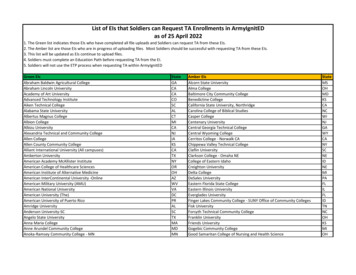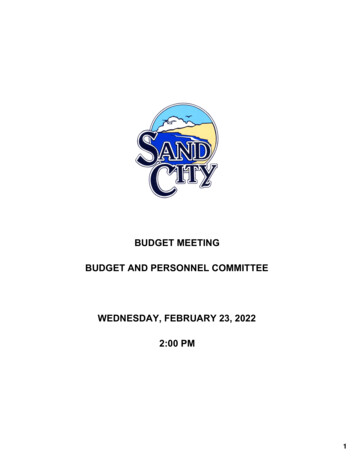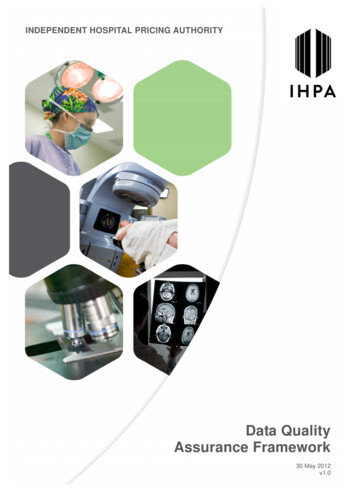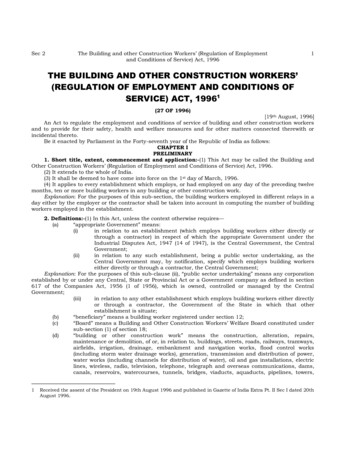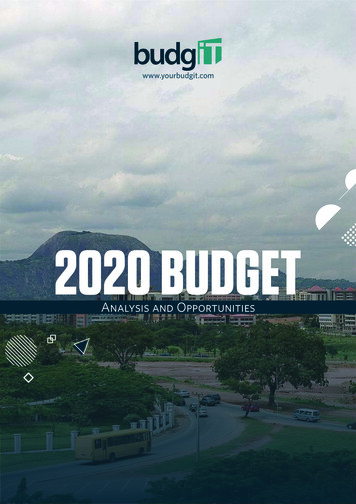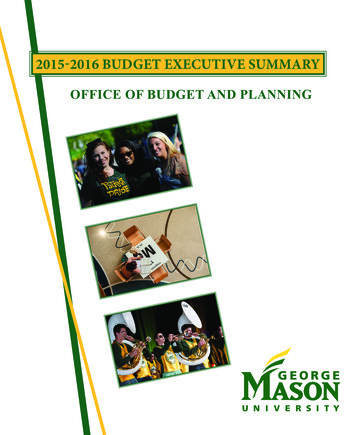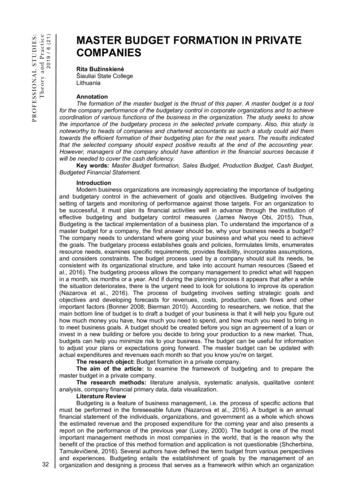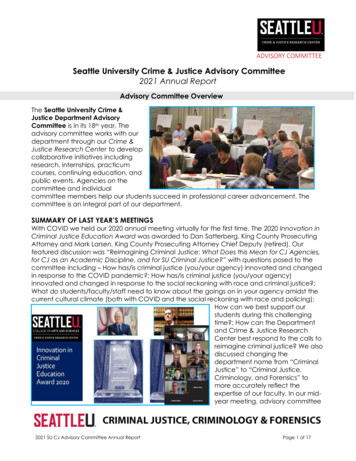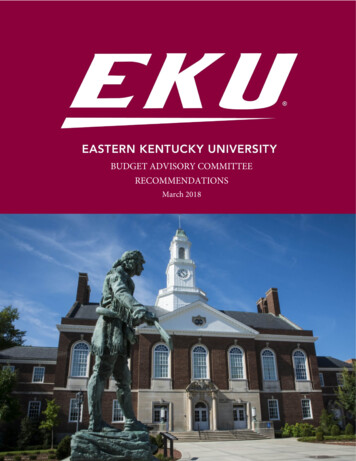
Transcription
BUDGET ADVISORY COMMITTEERECOMMENDATIONSMarch 20181
2Budget Advisory CommitteeChargeThe committee was charged by President Benson to identify and recommend a set of strategies toaddress an anticipated budgetary shortfall of 25 Million for fiscal years 2019 and 2020.Specifically, the committee was asked to engage faculty, staff, and administrators across theUniversity to identify cost reduction measures in a collaborative and open manner.MembersDavid McFaddin, Co-chairTanlee Wasson, Co-chairBurke Christensen (representing the EKU faculty-at-large)Mary Clements (representing the Chairs’ Association)Melinda Compton (representing the Provost’s Office)Stephanie King (representing the Staff Council)Mark Maier (representing the Office of Legal Counsel)Brett Morris (representing Student Success)Sarah Pitt (representing Human Resources)Barry Poynter (representing Finance and Administration, including Auxiliary Enterprises andAthletics)Matt Winslow (representing the Faculty Senate)Sara Zeigler (representing the Deans’ Council)Guiding PrinciplesWhen considering strategies, the committee used the following guiding principles: Protect students to the greatest extent possible, including scholarships, services, andprogramsConsider high-impact practices for student learning and successSupport EKU’s strong academic programs with opportunity for growthShield the essential services identified by constituent groups, including Libraries, TutoringServices, Student Employment, Information Technology, Registrar, e-Campus, and PublicSafety
3Work ProcessThe Budget Advisory Committee (BAC) received its charge in November 2017 and immediatelybegan working to develop a timeline for data collection and review. Three primary methods of datacollection were identified: 1) small group meetings with each VP area and other constituent groups,2) web-based survey, 3) review of data from the budget office, IT, and IR.One of the first decisions by the BAC was on the approach to collecting strategies from each VParea. The chosen methodology was to ask each VP to submit a variable level proposal identifyingspecific strategies for reducing expenses at the 15, 20, and 25% levels. In order to ensureconsistency in the information provided about each strategy, a template was developed thatincluded the submission form, position information, and budget detail for each VP area. The BACemailed each VP their specific templates on January 7th and requested submission of thecompleted templates by January 31st. Additional detail about this process is included in AppendixA.The web-based survey asked respondents to identify priority programs and services that should bepreserved and those that could be reduced or eliminated. The survey was open from December 9,2017 to February 27, 2018. The committee reviewed responses from 382 faculty and staff.Members of the BAC met with constituent groups throughout January. In addition to the officialcommittee meetings in Table 1, Dean Zeigler and Matt Winslow hosted three drop-in meetings forfaculty to provide more opportunities to hear their concerns and recommendations.Table 1: GroupMeetings ScheduleGroupCollege of ScienceStaff CouncilDeans’ CouncilEARN GroupCollege of Health SciencesChairs Steering CommitteeCollege of Letters, Arts, & Soc. SciFinance & AdministrationCollege of Business & TechnologyOpen Faculty ForumDepartment of AthleticsStudent SuccessAcademic Affairs Direct ReportsDevelopment & Alumni RelationsCollege of EducationStudent GovernmentCollege of Justice & SafetyEngagement & Regional StewardshipTentative DateJanuary 8, 2018January 9, 2018January 10, 2018January 10, 2018January 11, 2018January 12, 2018January 18, 2018January 18, 2018January 19, 2018January 22, 2018January 22, 2018January 22, 2018January 24, 2018January 24, 2018January 24, 2018January 25, 2018January 29, 2018January 30, 4:005:30-7:301:30-3:308:30-10:30
4University SummaryThe Budget Advisory Committee (BAC) worked with the five Vice Presidents throughout Januaryand February 2018 to identify strategies for reducing spending in their areas by 15%, 20%, and25%. Through extensive dialogue with the VPs and their cognizant reporting units, the committeeadopted a subset of strategies from each area to comprise the current set of recommendations forthe University. In doing so, the BAC avoided an across the board approach in which all areasreceived the same level of reduction. Rather, the committee focused on identifying and acceptingthe strategies that would have the least impact on students and the operation of the University.The strategies identified in this report will yield approximately 25.1 Million in spending across the2019 and 2020 fiscal years. Percent reductions in Table 2 are based on the unencumbered budgetfor each area. Expenses that are considered encumbered include student scholarships, debtservice, utilities, contracts (Aramark, Banner, TouchNet), course fees, and library acquisitions.Table 2: Strategy Totals by VP AreaPercent ofStrategiesUnencumbered UnencumberedVP AreaTotalBudgetBudgetBudgetAcademic Affairs 13,223,55012.4% 106,767,611 125,306,998Student Success* 1,964,6179.7% 20,244,484 75,553,151Regional Stewardship 1,681,55620.0% 8,425,853 9,388,908Athletics 2,025,80021.8% 9,310,472 9,310,472Development and Alumni 460,32214.9% 3,097,725 3,097,725Finance and Administration 1,732,7548.9% 19,476,876 44,232,844University** 4,055,535** 19,414,100TOTAL 25,144,13215.0% 168,286,076 286,304,198*All scholarships ( 36.3 Million), including Athletic Scholarships ( 6 Million) are included in theStudent Success budget.**The “Strategies Total” for the University category represents strategies that were outside ofindividual VP areas, including University Counsel, Employee Reclassifications, and reduction in a VicePresident. The amount yielded by these strategies is included in the table. The budget assigned to thiscategory represents budget items outside of the VP areas such as Debt Service/Bad Debt/Contingency,University Counsel, and the President’s office. Since the strategies in this area do not adhere to thebudgets assigned to those areas, the other two columns do not apply.
5KEY STRATEGIES Increased Revenue: new online bachelor's degrees in Criminal Justice, BusinessAdministration, Communication Studies and Sports ManagementElimination of Vice President and other administrative rolesAthletics reversion to pre-FBS bid levelClosure of the regional campus in DanvilleEmployee reduction: 96 filled positions, 57 vacant positions, and 37 RTP-partial lines 1Academic Program Suspension: 12 degree programs, 2 certificates, 4 minors, and 3concentrationsThe Committee is recommending a total of 505 strategies. The largest single strategy yields 1,068,724 in reduced expenses, while the smallest strategy yields 300. The average strategyreduction is 50,215 and the mode is 24,228.Since presentation of the report to the President’s Council on March 9th, position numbers have shifted due toretirements and resignations. These numbers reflect those changes and are updated as of April 5, 2018.1
6Academic Affairs 13,223,550The Provost and Deans Council used the 2016 program review list as a basis for reviewing degreeproduction and enrollment in all academic programs. As a result of that review, 12 degreeprograms, 2 certificates, 4 minors, and 3 concentrations are recommended for suspension. Allprograms recommended for suspension have a 3-year and/or 8-year average degree production ofless than 10, with the exception of the Associate Degree Nursing program (ASN).The recommended program suspensions identified in Table 3 represent 2.4 Million in expensereductions, with the majority from the ASN program at 1.1 Million. The Deans’ Council voted onand approved the suspension of these programs.Table 3: Program SculptureSchool PsychologyIndividualized BA, MinorMinorCert (2),Minors (2)ConcentrationPsySBISBTRisk Management & InsuranceBSScienceChemistryBAMathematics TeachingBSMathematical SciencesMSCLASSCLASSCLASSAcademic AffairsProgramBusiness & Marketing TeachingDeaf StudiesAmerican Sign Language StudiesFamily & Consumer Science TeachingNursingNursing AdministrationPE and Health : Students will transitionto the BBA in Risk Managementand Insurance.Transition: Students will transitionto the BS in ChemistryTransition: This program willbecome a concentrationembedded under the MathematicsBS programTransition: Students will transitionto the MA in Applied Mathematics
7The ASN degree program was identified by the College of Health Sciences as a strategicsuspension. The College of Health Sciences has intentionally reduced the number of enrolledstudents over the last several years. College leadership has indicated that strategic growth of theBSN program is a greater priority and that growth is limited in space and clinical placementopportunity by the continued offering of the Associates program. Additionally, most hospitals in theregion require a bachelor’s degree upon hire or within two years of hire. In order to better meetthose needs, an increased focus on growth of the Baccalaureate program will increase the numberof nurses at the requisite degree level for long-term employment in area hospitals. Additionaldetails are provided in the BSN growth plan (Appendix B).Academic Affairs leadership also identified 113 positions for elimination, as well as 37 RTP/ERTPpartial lines 2. Many of those lines were vacant as a result of the Provost’s decision to hold mostopen Academic Affairs positions in Fall 2018.Table 4: Academic PositionReductionsPosition TypeNon-tenured FacultyTenure-track FacultyTenured FacultyAcademic Support StaffTotalFilled Vacant1711035925166152Total1845941113KEY STRATEGIES Increased Revenue: new online bachelor's degrees in Criminal Justice, BusinessAdministration, Communication Studies and Sports ManagementPosition Reduction: 72 faculty positions, 41 academic staff positions and 34 RTP-partial linesAcademic Program Suspension: 12 degree programs, 2 certificates, 4 minors and 3concentrationsReorganization of academic support—combining departments, sharing administrative supportstaff, reduced Associate Dean and two Department ChairsReduction in operating budgetsDecreased graduate assistantships50% reduction in faculty professional development fundsADDITIONAL STRATEGIES Rigorous annual program review with benchmarks for degree completion and enrollmentNew process for evaluation and approval of reassigned time through the Provost’s officeEvaluation and redeployment of part-time faculty budgetsSince presentation of the report to the President’s Council on March 9th, position numbers have shifted due toretirements and resignations. The numbers on this page reflect those changes and are updated as of April 5, 2018.2
8Student Success 1,964,617Each unit within the Student Success area identified strategies in the individual areas: studentaffairs, career and co-op, first-year courses, university advising, retention and graduation, housing,and enrollment management.KEY STRATEGIES Reduction of freshman orientationStaff reductions and restructuringReduce international student recruitmentModify the First Year ExperienceCancellation of 3rd Party Contracts (Ruffalo Noel Levitz)Reduction in Student Health Services23 staff linesRegional Stewardship 1,681,556Leadership within the area of Regional Stewardship identified expense reductions throughtechnology changes, staff reductions, use of alternative funding, and closure of the regionalcampus in Danville.KEY STRATEGIES 13 staff linesClosure of the Danville CampusReduction of University support for WEKU to the minimum staffing requirements based on theagreement with the Corporation for Public Broadcasting.
9Athletics 2,025,800The committee reviewed the strategies put forward by Athletics at the 15%, 20% and 25% levels.These were inconsistent with guiding principles of the BAC. As an alternative, the committeerecommends a limited budget reversion to the pre-FBS conference bid budget, paired with astrategic team reduction.KEY STRATEGIES Roll back personnel and operational expenses to the 2014 levelElimination of the men and women’s tennis programsRationale for personnel and operational roll back:o During the bid for an FBS conference, significant increases in athletics expenditures weremade to align with benchmarks in those conferences;o Given the current budget restraints, the institution has decided not to pursue a FBSconference move;o The success of athletic teams prior to 2014 indicate that the recent increases are notnecessary to succeed in our current conferenceo No reduction in scholarships is recommended to ensure the commitments to our studentathletes are fulfilled. This is consistent with the committee’s position on not reducingstudent benefits.Rationale for elimination of the men’s and women’s tennis programs:o Two Kentucky comprehensives and several OVC peers have cut their tennis teams inrecent years, thus reducing competition in the conference and increasing competitionoutside the conferenceo There is a limited market for tennis in Kentucky and throughout the Midwesto There has been less investment in Tennis than the other teams in recent yearso Tennis facilities are easily repurposed for other uses
10Development & Alumni Relations 460,322The Committee spent a considerable amount of time reviewing fundraising and expense data forDevelopment & Alumni Relations, as well as discussing the nature and future of giving at theUniversity. Development officers provided a great deal of feedback to the committee’s questionsrelated to unrestricted and general fund giving. The committee recognizes that during a capitalcampaign deferred gifts are an expected form of giving. However, the BAC recommends arefocusing of efforts on strategies that yield greater amounts of current, unrestricted spendablefunds for academic colleges and programs, as well as the University’s Annual Fund. It is alsorecommended that a University Annual Fund goal be established each year.KEY STRATEGIES 4 staff lines and Vice President for Alumni and DevelopmentShifting costs for Foundation report to Foundation fundsSolicitation of sponsorships for alumni eventsFinance & Administration 1,732,754The areas within Finance & Administration were significantly impacted and reduced by the 2013reallocation and the outsourcing of custodial and grounds services in 2016. The magnitude ofprevious reductions in these areas limited strategies available during the current process.Additional cuts in many of these areas would greatly reduce necessary operational functions of theUniversity.KEY STRATEGIES 12 staff linesCampus energy infrastructure improvementsExtension of computer and laptop lease programs from 3-4 yearsEfficiencies in printing and mailing servicesOperational revisions at the Center for the Arts
11University Level Strategies 4,055,535In addition to the strategies put forth by each VP area, the committee identified some Universitylevel strategies to reduce expenses. These strategies include the strategic decision by thePresident to reduce the number of Vice Presidents from five to four, a savings of 200,000. Employee reclassifications, which will yield more than 1.2 Million in expense reductionReduction of 26 administrative positions listed in Table 5, for more than 1.8 Million in totalsavings (salary fringe) and average savings of 71,986 per positionReductions in underutilized scholarships and exchange agreementsReduction in the Post-secondary Waiver for employees at other Kentucky colleges anduniversitiesAppointment of a working group to evaluate the areas across campus that administer diversityservices and initiatives and identify opportunities for increased efficiency.Position TypeVice PresidentAsst./Assoc. Vice PresidentAssociate DeanDepartment ChairsDirectorAssociate DirectorResource/Operations /Grants mber1122627526Table 5: AdministrativePosition Reductions
12Next Steps This report will be submitted to the President on March 9, 2018.The Board of Regents will review the report on April 6, 2018.The President will appoint an implementation team by May 1, 2018.The committee will ask the President to appoint a working group to address diversityinitiatives by May 1, 2018.The current hiring freeze will end July 1, 2018. A revised hiring process that includes a 60day review period for all vacancies, as well as an associated exemption process will beimplemented at that time.
Appendix A: Strategy Development ProcessThis chart is a visual representation of the process the Budget Advisory Committee committee used to develop the strategies included inthe recommendations to the President’s Council. Templates and data were provided by the committee to each of the Vice Presidents. TheVPs engaged those in their units to identify strategies that were submitted back to the BAC. The BAC reviewed the strategies andadditional data to provide feedback and requests back to the VPs. In most cases there were multiple rounds of feedback and revisionwithin the VP area and between the VP and the BAC. Nearly every strategy included in the recommendations made by the committeeoriginated within the VP area. All academic programs recommended for suspension were strategies proposed by the College and Provost.Templates &DataProvostDeans/Directors/Deans' CouncilAssociateDeans/ChairsVP StudentSuccessAVPs/DirectorsVP StudentSuccessVP RegionalStewardshipDirectorsVP lBudgetAdvisoryAcademic AffairsWorking GroupProvostRecommendationsPresident’s CouncilBoard of Regents1VP Finance &AdministrationVP DevelopmentAVP(s)VP DevelopmentAtthletic DirectorAsst. DirectorAthletic Director
Appendix B:DEPARTMENT OF BACCALAUREATE AND GRADUTE NURSINGENROLLMENT PROPOSAL AND PROJECTIONSCurrent State:Current enrollment for pre-licensure BSN students completing requirements for admission into the clinical portion ofthe program is 550- 600, with 320 current enrollment in the clinical portion of the program. There are approximately100-120 students graduated each year with a BSN degree. Once the graduates from the BSN program pass theNCLEX licensure examination, they will be licensed as a Registered Nurse. The RN-BSN program, for graduates of ASNprograms to complete their BSN, enrollment is approximately 400-450 students with 150-200 graduates per year.Proposed Partnership Role: Secondary School PartnersSchools offer both career paths and dual credit. Schools partnering with EKU are excited to enhance work readinessand dual credit opportunities to assist students to earn college credit while still in secondary school.Different Paths:Accelerated High School Student Pathway: High school students will initially enter and follow the existing HealthSciences pre nursing or allied health Kentucky Career Pathway Program of Study. The pathway includes preparationfor nursing assistant job opportunities State Registered Nurse Aid (SRNA) credentials. These credentials will continueto be important for many students, as many students will need to obtain employment which will be compatible withentering Eastern Kentucky University) EKU later and completing a college degree. The initial SRNA credentials alone,however, do not serve to meet the growing demand for Registered Nurses (RN) in the Commonwealth and the sector;they also do not provide the economic opportunities available with obtaining RN licensure. Adding an acceleratedadmission route is critical to encouraging these students to continue their education and being eligible to sit forprofessional licensure.EKU recruiter/faculty and a professional advisor will help to recruit potential students into these pathways and willadvise them on dual credit courses to take to accelerate their admission into nursing. For students who are engagedin the career pathway, dual credit courses will also be offered to accelerate their admission into a BSN nursing majorat EKU. With following the pathways for allied health and the pre nursing SRNA, their interest in health care and nursingwill be enhanced through intrusive advising, and those who continue into studies at EKU can have their career goalsachieved faster. Students who take advantage of the opportunity offered will be able to complete enough dual creditsto enter college with at least the equivalent of one semester of college credits, and possibly two. Students who followthe recommended enhanced pathway to include dual credits courses will be considered in a separate category as dualcredit pre nursing students and so will be given an advantage for admission into one of the competitive EKU nursingprograms.Courses completed for dual credit are more economical than delaying coursework until after high school graduation.Students who meet the criteria for EKU scholarships will be able to take dual credit courses without incurring tuitioncosts. Students who meet the state criteria for the pre nursing pathway or who are completely general educationcourses will be eligible for those scholarships. Students who do not meet the criteria for the state or EKU scholarshipsare eligible for the reduced tuition rate offered by EKU (maximum of 1/3 KCTCS). Therefore, students who are advisedinto the dual credit courses and accelerated admission route will incur less student loan and other types of financialdebt when completing a post-secondary degree.How Secondary Students Will Receive Dual Credit/Post-Secondary CreditThe secondary students will receive dual credit/post-secondary credit through the established criteria of theCommonwealth and Eastern Kentucky University. Students who meet the GPA and ACT criteria for the EKU dual1
2credit scholarship can enroll in dual credit courses with tuition free and fee waived, and they will only need to supplythe cost of textbooks. Students who meet the state criteria for GPA and ACT and who are enrolled in an approvedpathway will also receive free tuition and waived fees, and they will only have to supply the cost of textbooks. Anyother students who do not meet that criteria will have to pay the tuition, which is currently 52.00 per credit hour.To help ensure their success in post-secondary education, students who meet the 3.0 or above GPA criteria, however,will be the ones recruited into the accelerated admission route as pre nursing dual credit students.The dual credit/post-secondary credit courses will be made available to the secondary students through courses atthe main EKU campus, through E presence technology, and through courses at the EKU Corbin Center. Students maytake up to a total of 8 dual credit courses, which will provide an accelerated entry into the one of the EKU nursingprograms. Intrusive advising will assist the students in selecting an individualized plan most suited for success withtheir career goals.The NSC 242 Communication in Nursing Course will be offered to the secondary students through E presencetechnology. The course will be taught by an EKU nursing faculty member.Furthermore, additional college credit courses will be available during the summer terms on the main EKU campus andalso at the EKU Corbin Center to give students who desire summer credits a chance to further accelerate their entryinto one of the nursing programs.Proposed Partners:We have a letter of support with Madison County Schools and Corbin High School. We are in the process of initiatingthis pathway.RN-BSN Pathway: Those who complete an Associate of Science in Nursing (ASN) can continue and complete the BSNin EKUs 100% online program. Those who complete the BSN can continue to complete a graduate degree in a NursePractitioner program and obtain additional credentials. These career and educational stop out points also allow for abreak in their education, if necessary for financial or personal reasons, without a loss of employment opportunities ora potential loss of credits.During the partnership, EKU will collaborate with the secondary partners to develop the most efficient and costeffective parallel career pathway for students and future students in their schools who are interested in nursing andhealth sciences careers.A recruiter/faculty member and a professional advisor can meet with potential groups of employees and facilitate theirentry into college level studies. Those who are already RNs will be recruited into RN-BSN programs or into MSN NursePractitioner Programs offered by EKU which are 100% online and therefore compatible with adult learners’ needs tomaintain employment while obtaining their college education. These 100% online programs were developed andoffered by EKU in response to requests from students and employers to serve the need of working students. Tuitionreimbursement is available from the health care partners for employees who are continuing their education. Studentsare actively engaged in the work force while obtaining additional education or credentials, and they are reaping thebenefits from tuition assistance and pay for employment. This route is better financially for students than entering intoa lengthy educational program with long delayed financial compensation and more accrued debt. Thus, they may beable to obtain their education and credentials with less student loan and other types of financial debt.Proposed Partner:EKU DBGN program is in communication with KCTCS system to be the program of choice for their ASN graduates toseamlessly transition to our RN-BSN pathway.
otal Increase6482*To increase the number of admissions must be approved by Kentucky Board of Nursing.**Fifteen percent is the highest the pre-licensure BSN can grow. The availability of large rooms in Rowlett and Dizneybuildings can only accommodate 90 student admissions each Fall and Spring.
less than 10, with the exception of the Associate Degree Nursing program (ASN). The recommended program suspensions identified in Table 3 represent 2.4 Million in expense reductions, with the majority from the ASN program at 1.1 Million. The Deans' Council voted on and approved the suspension of these programs. Table 3: Program Suspensions
